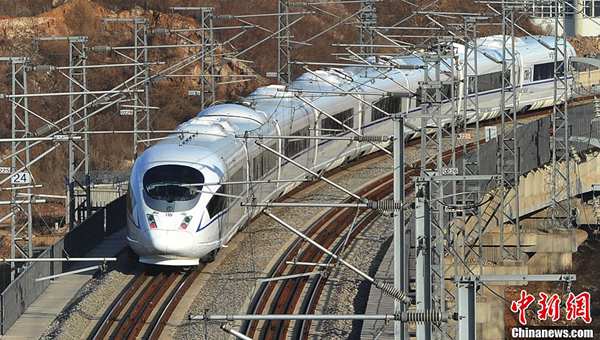

 |
The total mileage of China’s high-speed trains has surpassed 22,000 kilometers after a high-speed rail line linking Baoji and Lanzhou opened for traffic on July 9.
According to the medium-and long-term railway network plan issued by the State Council in 2008, China is to construct a “four vertical and four horizontal” railway network by 2020. With this, total railway expansion is expected to reach 120,000 kilometers, including 16,000 kilometers of high-speed rail.
The goal for 2020 was reached in 2015 when the “four vertical and four horizontal” railway network became reality and mileage for railway and high-speed railway exceeded planned figures.
Today, demand for high-speed railway is increasing as the daily volume of passenger transportation has reached four million.
As a result, China upgraded the goal in 2015, planning to form an “eight vertical and eight horizontal” rail network that runs 175,000 kilometers, including 38,000 kilometers of high-speed rail by 2025.
The medium-and long-term network plan aims to link Chinese cities with populations of over 200,000 with rail lines while high-speed railways will connect provincial capitals and large and medium-size cities by 2030.
The pace of development of China’s high-speed railway is therefore a marvel to the world.
On December 3, 2010, CRH380 from Beijing to Shanghai clocked record speed of 486 kilometers per hour during trial runs.
In mid July 2016, two trains travelling at 420 kilometers per hour in opposite directions bypassed each other on parallel tracks on the Zhengzhou-Xuzhou high-speed railway, the fastest of its kind.
On June 26, 2017, China's next generation bullet train, "Fuxing", debuted on the Beijing-Shanghai line.
China’s high-speed railway network runs 5,200 kilometers from east to west and 5,500 kilometers from north to south, traversing complicated geographical conditions across the country.
After years of technological upgrades and innovation, China has lifted its high-speed railway technology to the most advanced level. It has the advantages of low cost, quick delivery and acknowledged reliability.
The Shiziyang Tunnel on Guangzhou-Shenzhen-Hong Kong express rail link is intended to be the fastest underwater tunnel in the world.
From “four vertical and four horizontal” to “eight vertical and eight horizontal,” China’s high-speed railway network is a demonstration of speed and passion and represents the country’s glory and dream.
 Fire brigade in Shanghai holds group wedding
Fire brigade in Shanghai holds group wedding Tourists enjoy ice sculptures in Datan Town, north China
Tourists enjoy ice sculptures in Datan Town, north China Sunset scenery of Dayan Pagoda in Xi'an
Sunset scenery of Dayan Pagoda in Xi'an Tourists have fun at scenic spot in Nanlong Town, NW China
Tourists have fun at scenic spot in Nanlong Town, NW China Harbin attracts tourists by making best use of ice in winter
Harbin attracts tourists by making best use of ice in winter In pics: FIS Alpine Ski Women's World Cup Slalom
In pics: FIS Alpine Ski Women's World Cup Slalom Black-necked cranes rest at reservoir in Lhunzhub County, Lhasa
Black-necked cranes rest at reservoir in Lhunzhub County, Lhasa China's FAST telescope will be available to foreign scientists in April
China's FAST telescope will be available to foreign scientists in April "She power" plays indispensable role in poverty alleviation
"She power" plays indispensable role in poverty alleviation Top 10 world news events of People's Daily in 2020
Top 10 world news events of People's Daily in 2020 Top 10 China news events of People's Daily in 2020
Top 10 China news events of People's Daily in 2020 Top 10 media buzzwords of 2020
Top 10 media buzzwords of 2020 Year-ender:10 major tourism stories of 2020
Year-ender:10 major tourism stories of 2020 No interference in Venezuelan issues
No interference in Venezuelan issues
 Biz prepares for trade spat
Biz prepares for trade spat
 Broadcasting Continent
Broadcasting Continent Australia wins Chinese CEOs as US loses
Australia wins Chinese CEOs as US loses